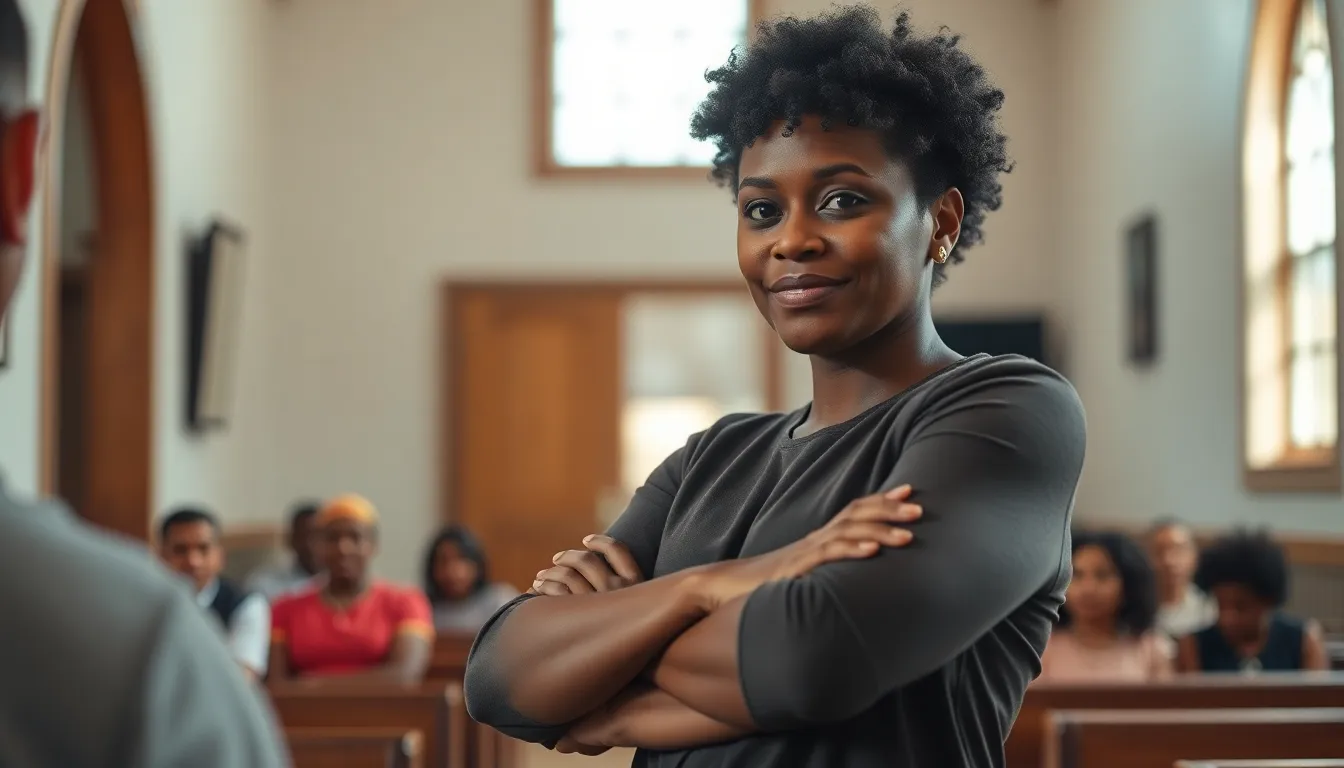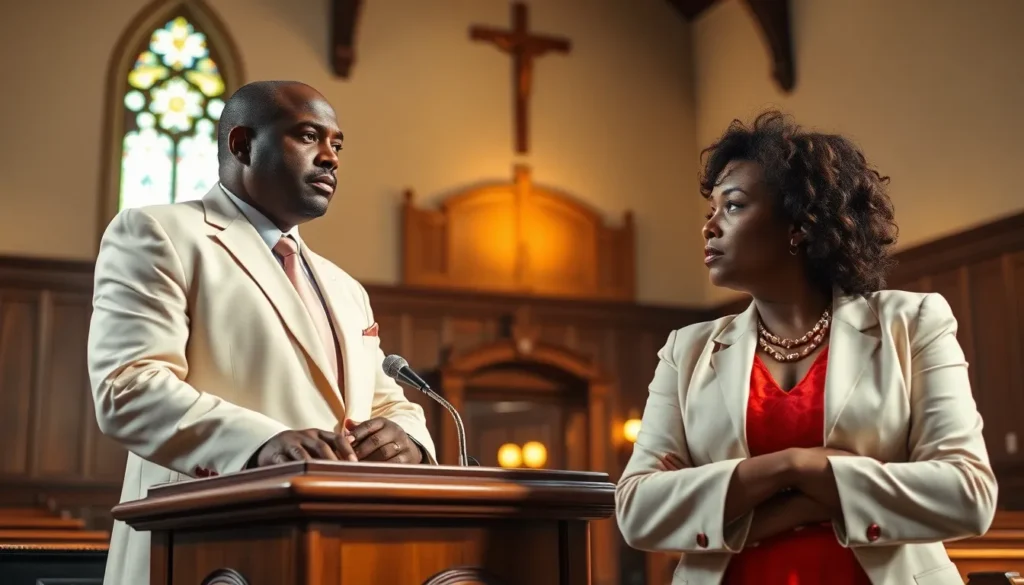In the heart of Harper Lee’s classic, To Kill a Mockingbird, two characters stand out like a pair of mismatched socks: Lula and Reverend Sykes. Lula, with her fiery spirit, isn’t afraid to speak her mind, while Reverend Sykes brings a touch of calm and wisdom to the tumultuous world of Maycomb. Together, they paint a vivid picture of the complexities within their community.
Overview of Characters
Lula appears as a passionate figure within the narrative of “To Kill a Mockingbird.” Her outspoken nature often draws attention, reflecting her strong feelings about racial injustice. Characterized by her willingness to confront others, Lula challenges attitudes in her community regarding race relations.
On the other hand, Reverend Sykes presents a contrasting demeanor. He embodies a sense of calm authority and wisdom, often guiding his congregation with compassion and insight. Sykes serves as a moral compass in Maycomb, advocating for justice and nurturing community bonds.
Interactions between Lula and Reverend Sykes illuminate the complexities of their community. Their differing approaches to social issues demonstrate a dynamic tension within Maycomb’s African American community. While Lula’s intensity energizes discussions around equality, Sykes seeks unity and understanding among his parishioners.
Both characters emerge in pivotal moments of the story, highlighting their distinct yet interconnected roles. Together, Lula and Reverend Sykes represent diverse perspectives on social change, each contributing to the narrative’s depth. Their portrayals enrich the depiction of Maycomb’s struggles, illustrating the nuanced responses to injustice and adversity faced by the community.
Lula Zeebo

Lula Zeebo stands out as a passionate and outspoken character in Harper Lee’s “To Kill a Mockingbird.” Her strong feelings on racial injustice make her a compelling figure within the narrative.
Background and Role
Lula lives in the African American community of Maycomb. She plays a pivotal role in a crucial moment when she confronts Reverend Sykes about the presence of white characters in her church. Her actions reflect her commitment to advocating for equality and reveal tension within the community. By challenging certain community norms, Lula emphasizes the need for change. Her outspoken nature adds depth to the story and highlights the complexities of race relations in the Deep South during the 1930s.
Key Traits and Characteristics
Lula embodies intensity and passion. She openly expresses her thoughts without hesitation, showcasing a willingness to challenge injustice. Empathy drives her responses to community issues, fostering dialogue about race. Pride in her heritage shapes her actions, as she pushes against societal constraints. Contrasting with other characters, her straightforwardness highlights the urgency of her beliefs. She serves as a voice for those who feel marginalized, symbolizing a desire for change within an oppressive environment.
Reverend Sykes
Reverend Sykes serves as a guiding figure in “To Kill a Mockingbird.” His character demonstrates a deep understanding of the complexities of community and race relations in Maycomb.
Background and Role
Reverend Sykes leads First Purchase African M.E. Church. He provides spiritual support to the local African American community, emphasizing unity in the face of societal challenges. Sykes faces racial tensions while advocating for his congregation’s moral and ethical growth. During a significant scene, he welcomes Scout and Jem, showcasing his commitment to inclusivity. His role extends beyond the church; he influences community dynamics, often advocating for social justice. By addressing issues like racism and poverty, Sykes strives to uplift his community.
Key Traits and Characteristics
Sykes exhibits calmness and wisdom. Many recognize him for his ability to listen and empathize with others. His commitment to justice drives his actions, fostering a sense of hope among his congregation. A strong moral compass guides his leadership, encouraging community members to navigate adversity together. Balance defines his character, as he seeks to unite rather than divide. Compassion flows through his interactions, reinforcing a message of resilience. His presence embodies a blend of faith and determination in the pursuit of equality.
Relationship Between Lula Zeebo and Reverend Sykes
Lula Zeebo and Reverend Sykes share a complex relationship that highlights differing perspectives on social change within the African American community of Maycomb. Their interactions reveal underlying tensions that stem from their distinct approaches to addressing racial injustice.
Lula embodies the voice of passionate advocacy, actively confronting Reverend Sykes regarding the exclusion of white characters from her church. This moment captures her fierce desire for equality and her willingness to challenge traditional norms. In contrast, Reverend Sykes takes on the role of a mediator, focusing on unity and compassion within the congregation. His leadership at the First Purchase African M.E. Church underscores a commitment to uplift his community through spiritual guidance.
The contrast between them reflects a broader dialogue on social issues. While Lula seeks immediate change and confrontation, Sykes emphasizes patience and understanding. Each character represents a different facet of resistance against oppression. Their interactions foster a deeper understanding of the complexities faced by African Americans in the Deep South during the 1930s.
Their relationship ultimately illustrates the balance between advocacy and community cohesion. Lula’s intensity complements Sykes’ calm demeanor, showcasing how both are essential in navigating adversity. Each plays a crucial role in their community’s dialogue on race, justice, and the quest for equality, enriching the narrative’s exploration of these themes. Through their exchanges, the story highlights the importance of diverse perspectives in the pursuit of social change.
Themes and Significance
Lula Zeebo and Reverend Sykes embody distinct perspectives on social justice and community dynamics in “To Kill a Mockingbird.” Their complex relationship illustrates the tension between immediate action and gradual reform within the African American community of Maycomb. Lula’s confrontational attitude towards Reverend Sykes highlights her intense dissatisfaction with racial injustices. This encounter reflects a broader criticism of complacency within the community.
Reverend Sykes’ calm demeanor serves as an anchor amidst chaos. By emphasizing empathy and unity, he guides his congregation through adversity. His welcoming approach toward Scout and Jem strengthens the theme of inclusivity, demonstrating faith’s role in fostering understanding across racial lines.
Contrasting methods in achieving social change become apparent when examining their interactions. Lula’s willingness to challenge societal norms contrasts with Sykes’ emphasis on patience and reflection. Each character’s viewpoint contributes to a richer dialogue on race relations, showcasing that multiple strategies exist in the pursuit of equality.
The thematic exploration of advocacy versus community cohesion emerges through their exchanges. Advocacy represented by Lula pushes for immediate change, while Sykes’ vision centers on unity and cooperative resilience. By articulating these diverse perspectives, the narrative deeply engages with the complex social fabric of the time.
Through Lula and Sykes, the story reveals the necessity of various approaches in advocating for social justice. Their significance lies not only in their individual characters but also in their collective representation of the African American struggle against oppression in the Deep South.
The dynamic between Lula Zeebo and Reverend Sykes serves as a powerful lens through which to examine the complexities of social change within the African American community. Their contrasting approaches highlight the multifaceted nature of activism. Lula’s fervent desire for immediate change challenges the status quo while Reverend Sykes’ calm guidance fosters unity and resilience.
Together they represent the diverse strategies necessary for addressing racial injustice. Their interactions underscore the importance of both confrontation and compassion in the fight for equality. As the narrative unfolds, it becomes clear that the journey toward social justice requires a blend of passionate advocacy and patient understanding, reflecting the ongoing struggle against oppression. This balance is crucial in navigating the intricacies of race relations, making their story both relevant and insightful.





